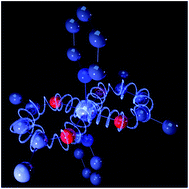Ligand field-actuated redox-activity of acetylacetonate†
Abstract
The quest for simple ligands that enable multi-electron metal–ligand redox chemistry is driven by a desire to replace noble metals in catalysis and to discover novel chemical reactivity. The vast majority of simple ligand systems display electrochemical potentials impractical for catalytic cycles, illustrating the importance of creating new strategies towards energetically aligned ligand frontier and transition metal d orbitals. We herein demonstrate the ability to chemically control the redox-activity of the ubiquitous acetylacetonate (acac) ligand. By employing the ligand field of high-spin Cr(II) as a switch, we were able to chemically tailor the occurrence of metal–ligand redox events via simple coordination or decoordination of the labile auxiliary ligands. The mechanism of ligand field actuation can be viewed as a destabilization of the dz2 orbital relative to the π* LUMO of acac, which proffers a generalizable strategy to synthetically engineer redox-activity with seemingly redox-inactive ligands.



 Please wait while we load your content...
Please wait while we load your content...